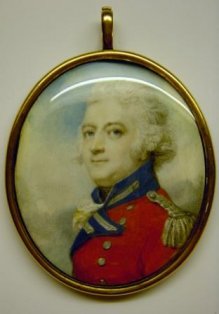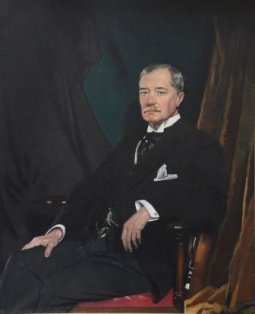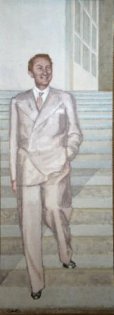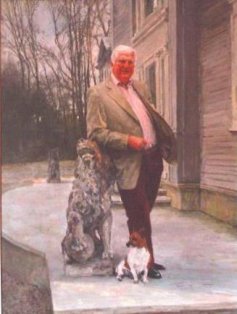
Edward Loveden Loveden

Alexander Henderson, 1st Lord Faringdon

Gavin Henderson, 2nd Lord Faringdon

Charles Henderson, 3rd Lord Faringdon (with Smudge), outside Plantation House

Edward Loveden Loveden

Alexander Henderson, 1st Lord Faringdon

Gavin Henderson, 2nd Lord Faringdon

Charles Henderson, 3rd Lord Faringdon (with Smudge), outside Plantation House




Edward Loveden
The original mansion and park at Buscot were built between 1780 and 1783 for Edward Loveden Loveden (c.1749–1822) by James Darley at the cost of £20,186 (about £780,000 in today's terms). Loveden’s family had acquired land in Buscot some two centuries previously, having purchased the manor of Michael’s Court from Sir Francis Stonor in 1557. Edward Loveden Townsend, who was born in Cirencester, inherited the estate in 1749, when still an infant, at the death of his great-uncle, Edward Loveden, the last direct male heir. In 1772, Townsend (as his uncle’s bequest required) changed his name to Loveden, having by then completed his education at Winchester and Trinity College, Oxford.
Loveden was an extremely wealthy individual, benefiting, as one biographer put it, ‘from his own father’s estate, inherited in 1787, the Loveden estate, and from three provident marriages’. He served as High Sheriff of Berkshire in 1781–2, as a magistrate in Berkshire, Wiltshire and Oxfordshire, as lieutenant-colonel of the Berkshire militia, and as an independent MP – first for Abingdon, from 1783 to 1796, then for Shaftesbury in Dorset, from 1802 to 1812. He was a co-founder of the Board of Agriculture (now the Royal Agricultural Society), in 1793, and he became its vice-president in 1807.
Perhaps his greatest achievement, for which he earned the nickname ‘Old Father Thames’, was to preside over the parliamentary committee of 1793 tasked with improving the Thames Navigation, from Staines, upstream in Berkshire, to Lechlade in Gloucestershire. Loveden was, in the words of Humphrey Household, historian of the Thames & Severn Canal, ‘a very active and purposive commissioner, and a powerful advocate for new cuts or canals which would improve navigation and shorten distances’. He also had a strong vested interest in the route of any proposed new canals, since the tolls he charged for the use of Buscot Lock were amongst the highest on the Thames and afforded him a considerable income. As one of the prime movers behind the Thames & Severn and the Wilts & Berks Canals, he devoted much energy to their planning and finance, though he resigned angrily and in disillusionment in 1812 when it became clear that his private interests were no longer being served.
Despite the provident marriages, Loveden spent a great deal on building Buscot and acquiring land. After his death in 1822, papers refer to the debts of the estate and to the fact that much of the additional land acquired between 1786 and 1792 was mortgaged. This continued to be the position as Buscot passed to Loveden’s son, Pryse Pryse, in 1822, to his grandson, Pryse Loveden, in 1849 and to his great-grandson, Sir Pryse Pryse, first baronet, in 1855. The latter’s main interests were in the Pryse estates in Wales, and in 1859 he put the Buscot estate on the market.
Robert Tertius Campbell
The new owner was Robert Tertius Campbell, an Australian tycoon whose wealth was founded upon gold trading in Australia. Like Loveden before him, he made major improvements to the estate, and he borrowed prodigiously to do so. A man of large and original ideas, that were much in advance of their time, he proceeded to turn Buscot into the most highly industrialised farm in the country.
Campbell is said to have been an enlightened employer, but there were miscalculations and misfortunes, and his grandiose projects consumed capital. His most ambitious project, a distillery set up to create spirit alcohol from sugar beet, was closed in 1879, and when Campbell died in 1887, the estate was left heavily in debt (though he himself still had assets of over £600,000).
Alexander Henderson, 1st Lord Faringdon
In 1889 Buscot was sold to Alexander Henderson, later 1st Lord Faringdon (1850-1934), a financier of exceptional skill and ability. Henderson was the second son of a distinguished Greek and Hebrew scholar, George Henderson of Langholm, Dumfries, and brother of Brigadier-General Sir Brodie Haldane Henderson, RE. His first job in the City was with Deloittes, a leading firm of accountants. Soon afterwards, he joined the stockbroking firm of Greenwood & Co., whose merger in 1932 with Cazenove Ackroyd was due to his efforts.
At an early age he became a leading figure in the City, financing a wide range of industrial and business enterprises, but specialising in the promotion of railways, both in this country and in South America. He was chairman of the Great Central Railway from 1889 until the regrouping of 1922 (when it became part of the London & North Eastern) and a major shareholder in the Manchester Ship Canal. He also held interests in port developments and telephone and electrical systems all over the world. During the First World War he launched the British Trade Corporation, serving as its first chairman. He was created a baronet in 1902, baron in 1916, and a Companion of Honour in the following year.
The 1st Lord Faringdon's political career was firmly allied to his business and commercial interests. He first entered the House of Commons as a Unionist MP in 1898, and became a strong supporter of Joseph Chamberlain's campaign for tariff reform, acquiring control of a newspaper, the Standard, to advocate these views. He later became a frequent speaker in the House of Lords on this and related subjects. At Buscot, he reverted to a more traditional policy of estate management than his predecessor, Robert Campbell, but rendered notable services to agriculture by his improvements to pedigree stock. He served as High Sheriff of Berkshire and as President of the Shire Horse Society. Lord Faringdon's eldest son, Colonel The Hon. H.G. Henderson, married Lady Violet Dalzell, daughter of the 14th Earl of Carnwath, but died in 1922, twelve years before his father.
Gavin Henderson, 2nd Lord Faringdon
Gavin Henderson, 2nd Lord Faringdon, thus succeeded his grandfather in 1934. Educated at Eton and Christ Church, Oxford, the 2nd Lord Faringdon had, in the 1920s, been a member of the set known as the ‘Bright Young Things’ immortalised in the novels of Evelyn Waugh and Aldous Huxley. But by the time he succeeded to Buscot he had developed a strong interest in public affairs, had joined the Labour Party, and had keenly supported the Republican cause in the Spanish Civil War. A convinced pacifist, he joined the Fire Service in the Second World War, serving with great courage during the blitz in London, Bristol and other large cities. After the war he sat on the executive committee of the Fabian Society until 1969, and was chairman of the Society’s Colonial Bureau from 1952 to 1958. He also served on the London County Council (LCC), as a councillor from 1958 to 1961, and as an alderman from 1961 to 1965. After the creation of the Greater London Council (GLC) in that year, he was appointed to serve on its Historic Buildings Committee.
During the 2nd Lord Faringdon’s day, Buscot was regularly used as the venue for conferences attended by prominent socialist politicians, the most celebrated being in 1970, after the fall of Harold Wilson’s Labour government. Buscot was also noted for its tradition of political weekend parties. But politicians were not the only visitors: the arts were also fully represented. Lord Faringdon was a trustee of the Wallace Collection and, in a house where the owner had amassed, rather than inherited, the majority of the contents (and was continually adding to them) this must have provoked many an enjoyable discussion.
The Faringdon Collection
In fact, what we see at Buscot today are the combined art collections of the first two Lords Faringdon. To say that their tastes were catholic is perhaps another way of expressing the fact that the accumulation of a collection of pictures was not of studied importance for either owner. Nevertheless, there are some fine works among those acquired by the 1st Lord Faringdon: Rembrandt’s portrait of the grave and introspective man, who may be Pieter Six, is a masterpiece of characterisation and Murillo’s Triumph of the Eucharist is an outstanding Catholic image, while the Burne-Jones Briar Rose series, pervaded by an intense imaginative power, belongs to the highest achievements of English nineteenth-century painting. Sadly, most of Lord Faringdon’s nineteenth-century English paintings, including Watts’s Choosing and Millais’ Esther, were dispersed at auction in July 1934; fortunately, three of the best examples, Watts’s Wife of Pygmalion, Ford Madox Brown’s Entombment, and Leighton’s Daedalus and Icarus, were bought back by his grandson.
The bulk of the pictures to be seen at Buscot today were purchased by the 2nd Lord Faringdon. His enthusiasm for adding to the collection, and his zeal for visiting dealers and auctions, remained with him until the day of his death. These accessions were never quite in the same realms of grandeur as those of the 1st Lord Faringdon – his predilections were more for diverse and minor examples, which had for him an instant appeal. But, together with pictures which pleased him for their element of fantasy, he added to the Italian pictures Palma’s Marriage of St Catherine and Pace’s St Jerome, and to the Flemish collection, the Rubens and Jordaens portraits, all of them worthy of the high seriousness of his grandfather.
Buscot Today
In 1948 Ernest Cook bought the Buscot Park estate, leasing the house and garden back to Lord Faringdon. The following year Cook gave the house and the surrounding 55 acres to the National Trust; he bequeathed the remainder of the entire estate as an endowment to the property under his will in 1956. Lord Faringdon continued to live there, as well as at Barnsley, an outstanding baroque building some twelve miles distant, which his mother had bought as a Dower House when he succeeded to Buscot in 1934. In 1962 he transferred the majority of the important contents of Buscot, with an endowment, to the Trustees of the Faringdon Collection. The heirloom pictures, excluded from this gift, were later handed over by his nephew.
The present Lord Faringdon (Charles Michael, 3rd Lord Faringdon) succeeded his uncle in 1977. He was educated at Eton and Trinity College, Cambridge,and did his National Service in the 16th/5th The Queen’s Royal Lancers. In 1959 he married Sarah (Askew); they have three sons and a daughter.
Lord Faringdon joined Cazenove & Co. in 1961 where he was a partner responsible for the firm’s Fund Management until 1996. He became a director of Witan Investment Trust plc in 1976, and was chairman for twenty-three years, retiring in 2003. His other interests have included the chairmanship of the Royal Marsden Hospital and the Institute of Cancer Research (at different times), and the Royal Commission on the Historical Monuments of England (1994-98). He also became a Commissioner for English Heritage (1998-2002), Honorary Treasurer of the National Arts Collection Fund, and Lord-in-Waiting to Her Majesty The Queen. Recently he has been appointed Pro-Chancellor of the University of West London.
In 1996, Lord Faringdon gave Barnsley Park to his second son, Thomas, and has recently moved out of Buscot House itself to allow his eldest son, James, and his family to live there, and has moved to a newly erected dower house (Plantation House) in the grounds.